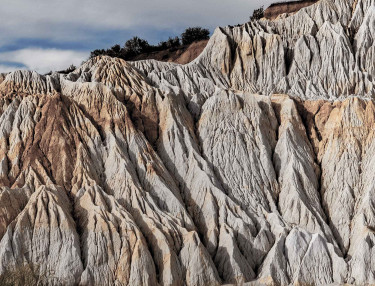SERIES: CERAMICS
Below you will find an explanation of the ceramic porcelain tiles product and its characteristics. The ceramic porcelain tiles are part of the Scandi-Roc product range:
Ceramic Porcelain slabs
The series is supplied in 20 mm slabs, which are available for outdoor as well as indoor use. Colloquially they are often called ceramic slabs, but the correct technical name is porcelain slabs.
CERAMICA pool coping stones are ceramic porcelain made of clay and are burned in kilns at high temperatures; the stones' properties depend on the composition of the clay mixture as well as the firing temperature: the higher the firing temperatures are, the denser and least water-absorbing the tiles will become.
Porcelain slabs are a ceramic product consisting of kaolinite clay, feldspar and quartz. After being compacted under immense pressure in a form, the tiles are fired. This takes place in kilns where the temperature is slowly increased to 1200–1400 degrees Celsius. Afterwards the kiln is rapidly cooled down, which transforms the clay into glass. This process is called sintering. The water absorption is less than 0.5%, which is the characteristic of a porcelain tile. The production technique makes it harder to produce a porcelain tile compared to a regular ceramic tile.
The ceramic porcelain slabs are frost-proof, acid-, chlorine- and oil-resistant. This makes them extremely maintainable and they can even withstand high-pressure cleaning.
The tile breaking strength as well as the general properties as described for 20 mm ceramic porcelain tiles makes this type extremely useful for outdoor and indoor tiling. Outdoor tiles are frost-proof and can - due to their enormous strength - be used on the terrace, in the driveway (requires concrete pad) and on the balcony. The outdoor tiles are easy to lay and can be laid on a variety of pads. They can easily be laid directly on grass, sand, gravel or they can be glued onto a concrete pad. Exactly as it is done with common concrete tiles or natural stone tiles. In addition, they can also be laid on small special units for, among other things, balconies.
SPECIAL NOTE ABOUT MARANELLO Pool coping: We recommend that the Maranello Pool coping is installed so that the underlying coating is at the same level, this so that the back edge of the coping stone will not be visible. The back edge of the Maranello design may have a thin centered line that has a different shade of color than the other rear edge. The Maranello design is produced/cut from raw sheets of 60x60 cm. In order to achieve the desired dimensions of 60x30 cm, you must therefore cut into the individual 60x60 tile. This means that you cut to the core, which explains the color shade on the back edge of the tile. If you want a Pool coping that must be installed with a visible back edge. Contact us and hear about the many options we have in our range.
Below we have described and explained the natural occurrences/characteristics that are found in the different stone types, and which one should be aware of when choosing the stone type, as these should not be mistaken for errors eligible for complaints.
Color variations
Ceramic porcelain tiles are made from natural materials, where every single production/firing is unique and there may therefore be minor deviations in color tone, surface and structure from each production run.
Nominal size >< working size
When it comes to ceramic pool coping stones and paving slabs, it's important to understand the terms "NOMINAL SIZE" and "WORKING SIZE". These dimensions play a vital role in achieving the perfect result in your pool coping and paving slab installations. Nominal size is the specified dimension of a pool coping stone or paving slab, usually measured in millimetres or centimetres. It is the size you see on the product label or in the product specifications. For example, a pool coping stone or paving slab may have a nominal size of 60x60x2 cm. It is important to note that the nominal size indicates the overall size of the stone. See the full size overview of NOMINAL SIZE >< WORKING SIZE for ceramic pool coping stones and paving slabs here.
Tools
As the breaking strength of Ceramic Porcelain Tiles is high (1 ton per cm2), you should carefully consider your choice of diamond blades, angle grinder and wet cutter before you start cutting. Both wet cutters and angle grinders must be able to hold the pivot point without being overloaded when the blade cuts the 20 mm compact porcelain tiles. Therefore, we recommend choosing equipment with a powerful motor with a part wat, such as a 1500 W angle grinder. A small angle grinder for 125 mm blades should have a minimum 1500 W motor and thermal protection. The large angle grinder for 230 mm blades should also have a thermal fuse and a motor of at least 2200 W. If you use a wet cutter, we recommend a motor of at least 2.2 kW; ie at least 3 HP for Ceramic 20 mm porcelain tiles.
Natural waste
Since we are dealing with a natural product, one must accept that there may be stones that are damaged in one way or another. Production and transport is associated with a great deal of handling. Within our industry a waste of up to 6% is accepted, the occurrence of which you as a customer must accept. This is especially true for larger shipments, where we recommend that this is included in the calculation. Tiles that are sorted out can be used eg at cutting etc.
Tolerances.
Tolerances of +/-2 mm in comparison to stated measurements should be accepted.

